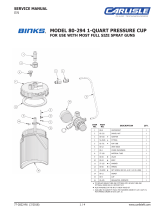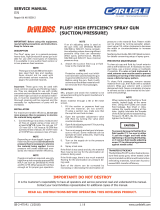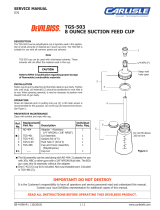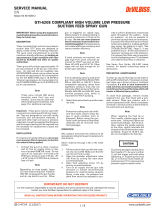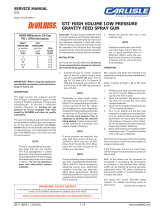Page is loading ...

SB-4-205-R1 (5/2018) 1 / 8 www.carlisleft.com
IMPORTANT! DO NOT DESTROY
It is the Customer's responsibility to have all operators and service personnel read and understand this manual.
Contact your local DeVilbiss representative for additional copies of this manual.
READ ALL INSTRUCTIONS BEFORE OPERATING THIS DEVILBISS PRODUCT.
EN
SERVICE MANUAL
KB II TWO-QUART PRESSURE CUPS
KB-555 ALUMINUM,
KB-545-SS STAINLESS STEEL
GOVERNMENT NSN NO. 4940-01-106-1415 = KB-555 CUP

EN
SB-4-205-R1 (5/2018)2 / 8www.carlisleft.com
Spray
Solvent Spray
Inhaling Toxic
Substances
Explosion Hazard-
Incompatible Materials
Adequate exhaust must be provided to keep air free
of accumulations of flammable vapors
Smoking must never be allowed in the spray area.
Fire extinguishing equipment must be present in the
spray area.
Wear eye protection.
Follow the requirements of the Safety Data Sheet supplied
by your coating material manufacturer.
Adequate exhaust must be provided to keep the air free
of accumulations of toxic materials.
Use a mask or respirator whenever there is a chance of in-
haling sprayed materials and its concentration. Equipment
must be as prescribed by an industrial hygienist or safety
expert, and be NIOSH approved.
Read the label or data sheet for the material you intend
to spray.
Do not use any type of spray coating material containing
these solvents with KB-555.
Do not use these solvents for equipment cleaning or flush-
ing with the KB-555.
If in doubt as to whether a material is compatible, contact
your material suppliers.
SAFETY PRECAUTIONS
This manual contains important information that ALL users should know and understand BEFORE using the equipment.
This information relates to USER SAFETY and PREVENTING EQUIPMENT PROBLEMS. To help you recognize this informa-
tion, we use the following terms to draw your attention to certain equipment labels and portions of this manual. Pay special
attention to any label or information that is highlighted by one of these terms:
Important information to alert
you to a situation that might
cause serious injury if instruc-
tions are not followed.
Important information that
tells how to prevent damage
to equipment, or how to avoid
a situation that might cause
minor injury.
NOTE
Information that you should
pay special attention to.
The following hazards may occur during the normal use of this equipment.
Please read the following chart.
Solvent and coatings can be
highly flammable or combus-
tible, especially when sprayed.
During cleaning and flush-
ing, solvents can be forcefully
expelled from fluid and air pas-
sages. Some solvents can
cause eye injury.
Certain materials may be
harmful if inhaled, or if there
is contact with the skin.
KB-545-SS is stainless steel and
can be used with Halogenated
Hydrocarbons.
KB-555 is aluminum. Solvents
such as 1, 1, 1- Trichloroethane
and Methylene Chloride (some-
times called methyl chloride)
can chemically react with the
aluminum used in most spray
equipment, and these cups, to
produce an explosion hazard.
HAZARD CAUSE SAFEGUARD
CA PROP
65
PROP 65 WARNING
WARNING: This product
contains chemicals known to
the State of California to cause
cancer and birth defects or
other reproductive harm.

EN
SB-4-205-R1 (5/2018) 3 / 8 www.carlisleft.com
IMPORTANT:
Read and follow all instructions and
SAFETY PRECAUTIONS before using this
equipment. Keep for future reference.
SPECIFICATIONS
Maximum regulated cup pressure - 50 psi (3.5 bar)
(fluid pressure)
Maximum air inlet pressure (to inlet on handle) - 125
psi (8.5 bar)
Hose Connections
Air - 1/4" NPS/BSPP (M)
Fluid - 3/8" NPS/BSPP (M)
Model Nos. KB-555 KB-545-SS
Height 7-3/16" 7-3/16"
Weight 3 lb. 14 oz. 4 lb. 5 oz.
Fluid Capacity 77 oz. Maximum
Wetted Parts:
Cup Aluminum 304 Electro
Polished S.S.
Lid Gasket Santoprene Santoprene
Check Valve Assy. Nylon Nylon
Fluid Tube Assy. Aluminum 304 S.S.
Passivated
Fluid Tube Nut Nickel Plated 304 S.S.
Brass Passivated
Cup Lid Aluminum Electroless
Nickel Plated
Aluminum
Bleed Down Valve
Nickel Plated 304 S.S.
Brass Passivated
KK-5051 Liners Polyethylene
DESCRIPTION
All KB-II style cups are pressure regulated
and have a 2.4 quart (77 oz.) capacity. They
are designed to be attached to any manual
spray gun with air and material hose. The
cup may be carried in one hand using the
comfortable hand grip or left on the floor
while spraying. The KB-II's wide diameter and
low profile provides a low center of gravity
which increases stability and resists tipping.
Models KB-555 and KB-545-SS include a 0-30
psi gauge. KB II cups are supplied with KK-
5051 disposable cup liners (5 each) to reduce
clean up time and cleaning solvent.
Pressure cups provide a greater degree of
control over atomization air and material
pressure than obtainable through use of
suction feed equipment. Pressure cups also
enable user to apply heavy or more viscous
materials in small amounts where a 2 quart
capacity is sufficient for the job.
INSTALLATION
Risk of injury. Cup is under pres-
sure. Disconnect cup assembly
from air supply before installing or
removing lid assembly from cup
for filling or cleaning.
1. Connect fluid hose (A) to fluid inlet of
gun and outlet of cup (1) as shown. See
Figure 1.
2. Connect atomization air hose (B) to air
inlet of gun and outlet of cup (2) as shown.
See Figure 1.
3. Connect air supply hose (C) to inlet cou-
pling (3) on cup handle. See Figure 1.
NOTE
Order hoses separately.
See "Accessories", page 4.
OPERATION
Risk of injury or equipment damage.
Air pressure to the cup must never
exceed 50 psi, (3.5 bar).
Mix and prepare the material to be sprayed
according to manufacturer's instructions.
Strain material through a 60 to 90 mesh screen
or equivalent before spraying. Place KK-5051
disposable liner into cup. Refer to instructions
provided with KK-5051.
C
CleanAir
Filter
A
B
2
1
3
Air Inlet
Figure 1

EN
SB-4-205-R1 (5/2018)4 / 8www.carlisleft.com
Safety Valve, Regulator, Pressure Gauge
The safety valve limits the maximum
air pressure. If the safety valve does
not work properly, over pressuriza-
tion may occur and cause the cup
to rupture or explode. Occasionally
pull the ring on the safety valve and
make sure it operates freely. If the
valve is stuck or does not operate
smoothly, it must be replaced with a
valve having the same rating. Never
attempt to adjust or disassemble the
safety valve.
The safety valve (14) is factory set at approxi-
mately 55 lbs. Never disassemble. If damaged,
replace. Never submerge in solvents.
Regulator Disassembly
1. Pull the knob on the bonnet outward to
unlock regulator knob.
2. Turn the knob counterclockwise to stop.
3. Remove bonnet (24) by turning it coun-
terclockwise. Use pliers if necessary.
4. Remove adjusting screw and nut, regu-
lating spring, slip ring and diaphragm.
5. Use a wide blade screw driver and turn
valve seat (18) counterclockwise to re-
move along with o-ring.
6. Carefully remove valve (17) and valve
spring (16).
Regulator Reassembly
1. Place valve spring (16) into center hole of
cast housing. Place valve (17) on the
spring (16).
2. Use a wide blade screw driver and
tighten valve seat and o-ring assembly
(18) to 4-6 in. lbs. torque.
3. Place diaphragm (19) on the valve seat.
Diaphragm tube must slide freely through
valve seat after valve seat is torqued
into the body.
4. Place slip ring (20) on inside shoulder of
bonnet (24).
5. Place adjusting screw (23), nut (22) and
regulating spring (21) into bonnet (24).
6. Tighten bonnet assembly (24) to 65-75 in.
lbs. torque.
PREVENTIVE MAINTENANCE
Always relieve pressure in cup be-
fore removing lid by turning bleed
valve out.
NOTE
Do not unthread the pressure bleed
valve (6) all the way, as it may fall
out and be lost.
Cleaning
Do not wash the lid assembly in a
gun washer. The safety valve, gauge
and regulator contain parts that will
be damaged. The cup only can be
washed in a gun washer.
Use of the KK-5051 disposable cup liner
will significantly reduce cleaning time and
sol-vent. Another accessory item, KK-5052
Adapter and Hose Kit, can also be used in
conjunction with the Solvent Saver™ to
save further time and solvent cleaning the
fluid passages of the tube, hose, and spray
gun. See Accessories page 4.
Grasp lid handle and push down with one
hand and turn the retaining ring (1) counter-
clockwise with the other hand. Pour out any
remaining material and add a suitable solvent.
Close cup lid as explained in "OPERATION"
section. Spray until clean solvent appears.
Cup and gun material passages should now
be clean. Empty any remaining solvent from
cup. Wipe cup with a solvent soaked cloth.
Check Valve
If contaminated, carefuly remove check valve
(12) from lid. Soak in suitable solvent. If dam-
aged, replace. Do not torque to more than
10 in. lbs.
Description of Controls (Ref. Fig. 2, page 5)
Regulator Assembly (15) - Controls pressure
on material in cup.
Pressure Bleed Down Valve (6) - Allows air
to be bled from cup
To reduce pressure in cup, turn knob of regu-
lator assembly counterclockwise. Bleed off
excess air by momentarily turning pressure
relief valve (6) counterclockwise. Readjust
pressure by turning knob of regulator (24)
assembly clockwise. Turning regulator all
the way out shuts off air supply to the cup.
NOTE
Turn pressure bleed valve (6) coun-
terclockwise to vent air from the
cup; it is important to do this before
removing lid.
1. Place lid on cup. Grasp lid handle and
push down with one hand and tighten
retaining ring (1) with other hand.
2.
Turn regulator knob (24) out (counter-
clockwise) until no spring pressure is felt.
3. Close pressure bleed valve (6) by turning
it in all the way clockwise.
4. Set air supply pressure at approxi -
mately 50-60 pounds at regulator.
5. Set material pressure at 10 pounds by
turning in regulator knob and reading the
gauge. Make sure fluid adjusting screw
on spray gun is open (turned out coun-
terclockwise until first thread shows).
6. Test for amount of paint in relation to the
speed at which you want to spray. If too
much paint is coming out or atomized
particle size of paint is too large, follow
one of the procedures below.
A. Turn regulator knob counterclock-
wise until gauge shows lower pres-
sure. Bleed off excessive air in cup by
turning pressure bleed valve (6) coun-
terclockwise.
B. Raise air pressure at regulator
until well defined atomized pattern of
paint is evident. This increases air pres-
sure to spray gun while maintaining
same pressure in the cup.
TROUBLESHOOTING CHART
PROBLEM CAUSE CORRECTION
Excess pressure in cup. Gauge (8) registering incorrectly Replace.
Safety valve (14) setting too high. Replace.
Valve spring (16) broken or distorted. Replace.
Diaphragm (19) damaged. Replace.
Leak at regulator valve (17 and 18). Replace.
Insufficient pressure in cup. Safety valve (14) leaking. Replace.
Check valve (12) stuck shut. Clean or replace.
Gauge (8) registering incorrectly. Replace.
Leak at cup lid (11) threads. Tighten cup or replace gasket (9) or slip ring (2).

EN
SB-4-205-R1 (5/2018) 5 / 8 www.carlisleft.com
• These parts are included in the Regulator Kit
KB-428-1.
# Recommended Spare Parts and KB-428-1
Regulator Kit.
* A secondary handle (3) has been provided with
each cup. May be used for "Belt Hanging".
+ These parts are included in Ref. No. 267,
Fluid Tube Kit.
✖ Apply thread sealant (i.e. Loctite #242 medium
strength blue or equal) unto threads.
PARTS LIST
6
✖5
3
2
1
✖5
4
20
21
17
16
19
27
25
26
24
15
18
Figure 2
22
23
13
12
14
9
8
7
10
27
11
Ind.
Ref Replacement Parts
No. Part No. Description Req.
1 KB-64 Retaining Ring 1
#2 KB-81-K5 Slip Ring (Kit of 5) 1
*3 KB-74 Handle - Secondary 1
4 --- Nut 5/16"-18 (purchase locally) 1
5 P-MB-51 Adapter 2
#6 KB-66 Pressure Bleed Valve (For KB-555) 1
# KB-95 Pressure Bleed Valve (For KB-545-SS) 1
7 KB-70 Lid w/handle (For KB-555) 1
KB-93 Lid w/handle (For KB-545-SS) 1
8 GA-355 Pressure Gauge 0-30 psi 1
#9 KB-80-K5 Gasket (Kit of 5) 1
+10 MBD-11-K5 Locknut (For KB-555, Kit of 5) 1
KB-97-K2 Locknut (For KB-545-SS, Kit of 2) 1
11 KB-422 2 qt. cup (For KB-555) 1
KB-442 2 qt. cup (For KB-545-SS) 1
12 KB-432-K3 Check Valve (Kit of 3) 1
#13 KB-85-K5 Gasket (Kit of 5) 1
14 TIA-4355 Safety Valve 1
15 KB-428-1 Regulator Kit 1
•16 --- Valve Spring 1
•17 --- Valve, PTFE 1
•18 --- Valve Seat and O-Ring Assembly 1
•19 --- Diaphragm, PTFE protected 1
•20 --- Slip Ring 1
•21 --- Regulator Spring 1
•22 --- Nut 1
•23 --- Adjusting Screw 1
•24 --- Bonnet 1
+25 KB-60-K6 Gasket (Kit of 6) 1
+26 --- Fluid Tube Assembly
27 KK-4997 Fluid Tube Kit -
(Aluminum For KB-555)
1
KK-4996 Fluid Tube Kit - (Stainless Steel 1
For KB-545-SS)

EN
SB-4-205-R1 (5/2018)6 / 8www.carlisleft.com
HAV-500 OR
HAV-501
Adjusting Valve
(HAV-501 SHOWN)
HAV-500 does not have
pressure gage. Use to
control air usage at gun.
HARG-510 Air
Regulator
Use to maintain nearly
constant outlet pres-
sure despite changes
in inlet pressure and
downstream flow.
Enables user
to control and re-
duce air usage at
the gun. Ideal for
low pressure spray-
ing.
P-H-5516
Air
Adjusting
Valve
Contains all
necessary tip,
hose and nut
sizes used on
or with gun.
WR-103
Wrench
These brushes are
helpful in cleaning
threads and recesses
of gun body.
42884-214-K5 3/8"
42884-215-K10 5/8"
Cleaning Brushes
ACCESSORIES
Compatible with all paint
materials: contains no
silicone or petroleum
distillates to contaminate
paint. SDS available upon
request.
SSL-10 Spray Gun Lube
(DeVilbiss Automotive
Refinishing)
2oz.
Bottle
Scrubs
®
are
a pre-moist-
ened hand
cleaner towel
for painters.
No water is
needed.
192218 Scrubs
®
Hand Cleaner Towels
(DeVilbiss Automotive
Refinishing)
29-3100 Scrubs
®
Hand
Cleaner Towels
(Binks – Industrial)
Allows flushing of cup tube, hose and gun using
SolventSaver™. Kit includes: HD-410 adapter
fitting and 2' hose assembly.
KK-5052 ADAPTER FITTING and
HOSE KIT
KB II
Solvent
Saver™
Keeps cup and
lid isolated from
paint reducing
clean up time
and solvent.
Kit includes:
20 liners
20 lids
3 rings
KK-5051 Disposable
Cup Liner
KB-4006
6 ft. Hose Assembly
Includes 6 ft. air hose
and 6 ft. fluid hose and
connections.

EN
SB-4-205-R1 (5/2018) 7 / 8 www.carlisleft.com
NOTES

EN
SB-4-205-R1 (5/2018)8 / 8www.carlisleft.com
WARRANTY POLICY
This product is covered by Carlisle Fluid Technologies’ materials and workmanship limited warranty.
The use of any parts or accessories, from a source other than Carlisle Fluid Technologies,
will void all warranties. Failure to reasonably follow any maintenance guidance provided
may invalidate any warranty.
For specic warranty information please contact Carlisle Fluid Technologies.
For technical assistance or to locate an authorized distributor,
contact one of our international sales and customer support locations.
Region Industrial/Automotive Automotive Renishing
Americas
Tel: 1-800-992-4657 Tel: 1-800-445-3988
Fax: 1-888-246-5732 Fax: 1-800-445-6643
Europe, Africa,
Middle East, India
Tel: +44 (0)1202 571 111
Fax: +44 (0)1202 573 488
China
Tel: +8621-3373 0108
Fax: +8621-3373 0308
Japan
Tel: +81 45 785 6421
Fax: +81 45 785 6517
Australia
Tel: +61 (0) 2 8525 7555
Fax: +61 (0) 2 8525 7575
Carlisle Fluid Technologies is a global leader in innovative nishing technologies.
Carlisle Fluid Technologies reserves the right to modify equipment specications without prior notice.
DeVilbiss
®
, Ransburg
®
, ms
®
, BGK
®
, and Binks
®
are registered trademarks of Carlisle Fluid Technologies, Inc.
©2018 Carlisle Fluid Technologies, Inc.
All rights reserved.
For the latest information about our products, visit www.carlisleft.com
/


